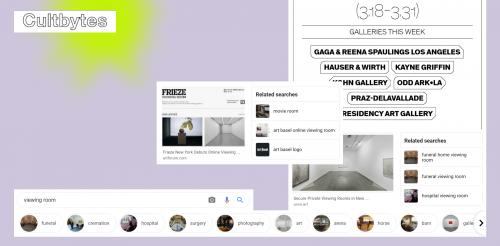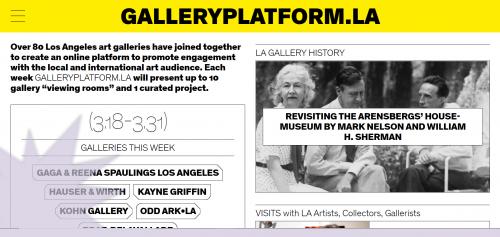Can Virtual Platforms Help Chip Away ‘Exclusivity’ from the Art World?
22 march, 2021
The worldwide, months-long lockdowns imposed as a result of Covid-19 transformed the way in which institutions could present artwork and challenged one of the fundamental elements of the art market: exclusivity. Galleries, in particular blue-chip galleries, thrive on exclusivity. From the design of the spaces to the interactions with clients, blue-chip institutions build their brands by creating a sense of being inaccessible. Public openings and viewings are often second offerings, the first picks already passed around a select group of targeted collectors and museums. The same can be said for art fairs. The works on the walls of a fair are often pre-sold and are rotated out of the space by the end of the day, lending an air of just having missed out to a client who hesitated. Regardless of whether works are for sale or not, oftentimes the only people who have the privilege of seeing any of these pieces are those who can afford to travel to the fair, buy a ticket (or receive a VIP pass), and pay the inflated hotel costs for their visit. With Covid-19, the entire operation of the art world has changed, and the result of this change might be the very degradation of exclusivity that the industry needed.
Accessibility and inclusivity in the art world are major issues in nearly every sector of the industry. The very model of a blue-chip gallery is that of the white cube—austere, white walls, often-windowless spaces designed by famous architects. These spaces are specifically designed as psychological barriers, cold, unwelcoming spaces that ensure the people entering the room are only those who are invited and entitled to be there. The stereotypical gallery staff consists of older, white, male directors with white, male salespeople and young, white, female assistants. The stereotypical roster of artists is much the same–older, white men, some white women. While these sectors are slowly changing, they are inevitably controlled by the institutions themselves. Current and former employees of many galleries have fought against the lack of diversity within the art world, most publicly through social media, such as the Instagram account @cancelartgalleries that collects and reports anonymous stories of racism, exploitation, and other abuse in the commercial art world. A similar account for museums has forced management at several institutions to address issues of discrimination and has even led to changes in staff. The final element of the art world, the viewers and the collectors, is where we have seen a shift in the last decade, and much of this shift has to do with the galleries’ decreasing control over their audience with the increase in participation of the general public.
With Covid lockdowns, the idea of galleries as public spaces was completely eliminated. No longer could anyone wander into a gallery to view their current offerings. The little accessibility that the public space of the gallery offered was removed. However, as much as galleries operate privately, selling works that never see the public eye, they inevitably need the element of the general public to survive. Recognizability in the art world is paramount for branding. A large turnout of young, hip, Instagramming people can push a sale across the finish line. Without the physical space of the gallery, online viewing platforms have become crucial to maintaining a gallery’s relevancy in addition to its sales.
At the beginning of the pandemic, galleries and large art fairs clung desperately to the status quo. Basel Art Fair waited months to cancel their in-person summer fair held annually in June in Basel, Switzerland. While fair organizers originally postponed the summer 2020 edition until September, pressure and concerns from participating galleries led to its cancellation altogether. They did the same for the Miami iteration held in December, waiting until it was absolutely clear that an in-person fair was impossible, and then opting for an online version of the international event. Suddenly, the elitism that these fairs depend upon began to chip away. Without the costs of travel and accommodation, the pool of people able to view what these galleries had to offer expanded dramatically.
While the ability to attend art fairs and exhibitions increased as a result of the shift to digital, the question remains whether increased accessibility translates to increased sales.
Without reports from individual galleries, it’s unclear how well-attended the virtual spaces really are, but Art Basel’s mid-year UBS Global Art Market Report gives an idea of the impact of Covid-19 on art sales. With 795 galleries and 360 high-net-worth people surveyed, the report has shown that sales, in general, were down 36 percent in the first half of the year, but that there was a rapid increase in digital sales. According to the report, online sales represented 37 percent of the total sales volume compared to just 10 percent last year. New clients represented 26 percent of online sales, suggesting that there is indeed a benefit to the increase in outreach possible with the online platform. On the contrary, Art Basel’s parent company, Swiss MCH Group, reported a loss of 55 percent of its own business in the first half of 2020 compared to 2019.
While there is no doubt that virtual exhibitions and online viewing rooms cannot replace the experience of being in front of an artwork, there is something to be said about the increased accessibility that comes with this virtual territory. Hauser and Wirth, for example, created virtual exhibitions for their Frieze Masters and Frieze London booths, allowing anyone who visited their website to see their presentation without any cost. Included in their booth was a new work by Mark Bradford, part of his “Quarantine Paintings,” thus giving an opportunity for collectors and non-collectors alike to see the artist’s new work. While Hauser and other galleries are embracing the virtual platform, it’s unclear if this is a temporary adaptation to the current environment or a shift altogether. The question here is whether the leaders of the art world want to become more accessible.
For some galleries, the use of virtual platforms presents the opportunity to expand their outreach to a wider audience. In Los Angeles, galleries came together immediately after lockdown to address the shift to online viewing and created an entire website to collectively display their online shows. Launched officially on May 14th, the website, called GalleryPlatform.LA, presents 10 gallery viewing rooms and one curated project each week. The platform, which states its purpose as “to promote engagement with the local and international art audience,” now consists of 81 LA galleries. A similar program called 8-bridges was created in October in the Bay Area.
Online viewing spaces were already in use before lockdown, often privately as a tool to attract clients who were not able to see the show in person. Sometimes taking the form of a PDF or a password-protected website with images and information, these viewing spaces are more direct in their function—to sell artwork. Gagosian, for example, has experimented with online viewing platforms over the last few years. Some of the viewing rooms were standalone shows and others complemented art fairs, as was the case with their viewing room created to coincide with the Los Angeles iteration of the Frieze Art Fair that took place in February of this year. The works in this viewing room were each displayed with props to give a sense of scale, but there was still no doubt that their function was to sell artwork. Visitors to the viewing room had the ability to live chat with a specialist at any hour, thus ensuring no sales were missed.
Unlike this concept of a purely sales-focused viewing room, the virtual spaces that galleries are now using in place of the in-person experience balance this necessary role of a sales tool with the entertainment value of an exhibition. Los Angeles printmaking studio and gallery Gemini G.E.L., for example, created a walkthrough film of their exhibition “John Baldessari: 30 Years at Gemini G.E.L.” both for their GalleryPlatform.LA project and to complement the exhibition page on their website.
Similarly, Hauser and Wirth has set up their virtual exhibitions so that videos of the artists working and text about the works are interspersed among images of the pieces themselves. For their new exhibition on the artist Amy Sherald, the viewer can read about her practice and view a video of the artist working before seeing the new gouache portraits. Compared to the webpage for the gallery’s show of the artist’s work from September and October of last year, the current virtual exhibition is more engaging and comprehensive. Whereas the previous exhibition page offered installation shots and select images, the virtual show takes steps to feel more like an interactive experience.
In addition to galleries extending their outreach, art viewers themselves can expand their interest and engagement through virtual platforms. With the ease at which online exhibitions can be accessed, there is less of a participatory commitment for the viewer. One can easily view an exhibition that one may not have been willing to dedicate the time or resources to see before. People can now view an online tour or join in on a virtual performance piece that they would normally not have allotted time for. Moreover, viewers who might not have felt comfortable breaching the psychological barrier of the white cute no longer have that physical threshold holding them back. While there have not been reports of expanded viewership, the simple fact that people can easily view a show in Brussels while sitting in their home in New Jersey at least allows for greater accessibility.
At the end of the day, blue-chip galleries will continue to offer works privately and the general public will continue to be in the dark about the very existence of many incredible works of art. Indeed, there is no doubt that private offers and still being made and private virtual viewing rooms exist. While this exclusivity is inevitably a fundamental characteristic, even an important sales tool, that helps galleries build a brand and make a profit, the breaking down of exclusivity has opened the art world to new methods of participation and consumption. If there is a lesson to learn from Covid-19 lockdowns, it is that virtual exhibitions can serve a purpose to complement physical viewing spaces with additional resources like video and text to expand the art world’s outreach and broaden the viewer’s own activities.
A version of this article was also published in Cultbytes.
Support us on Patreon to read more articles about Ukrainian contemporary art.Share:



